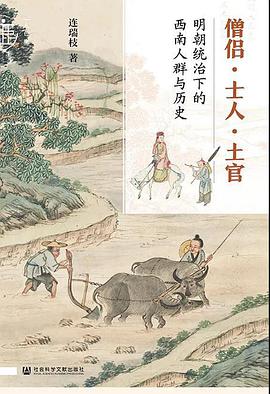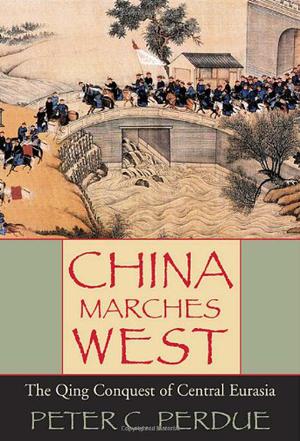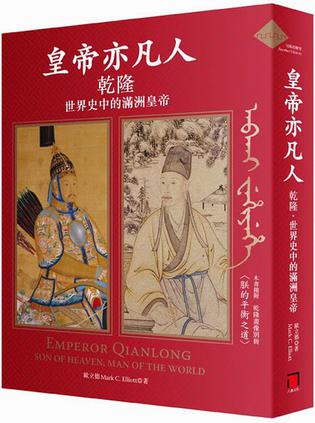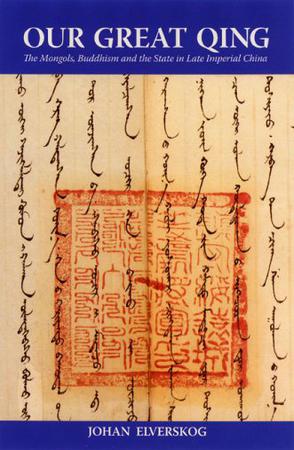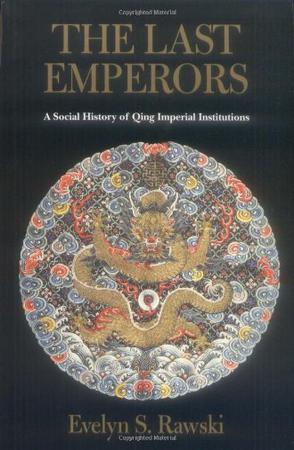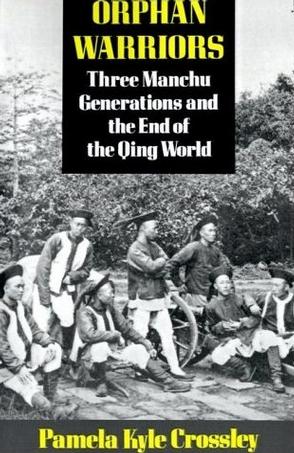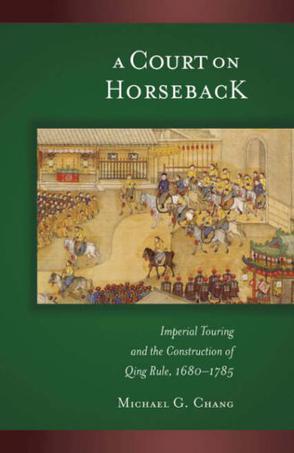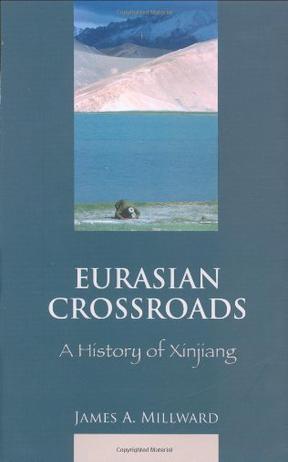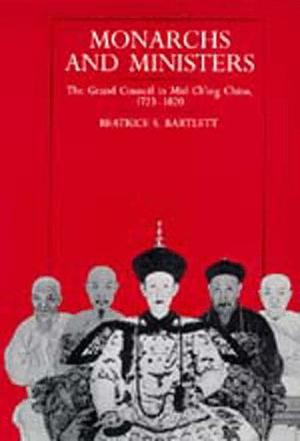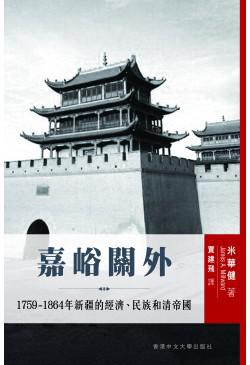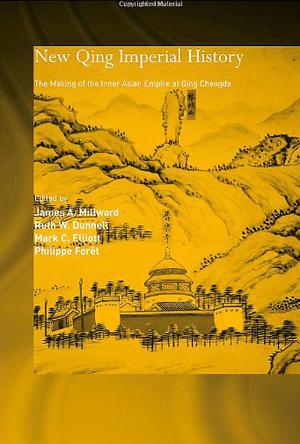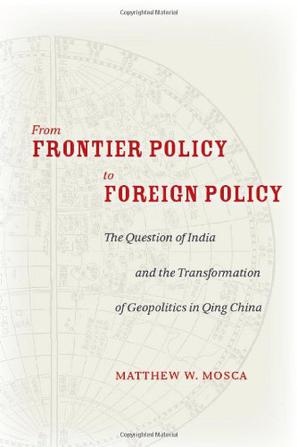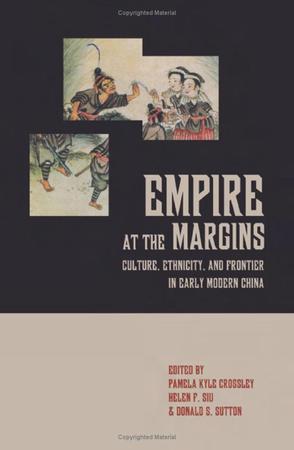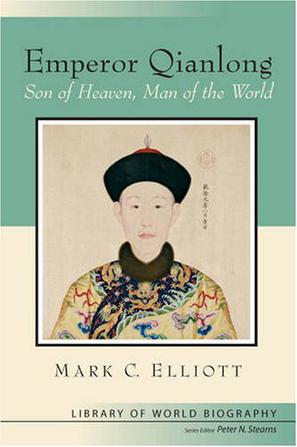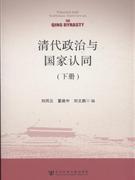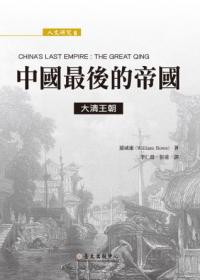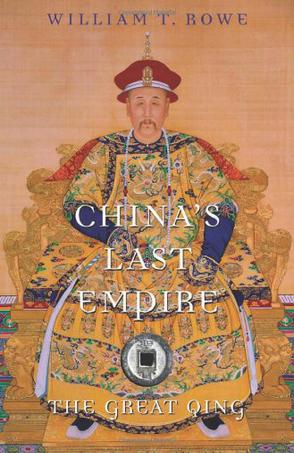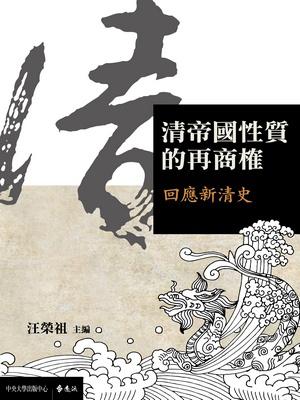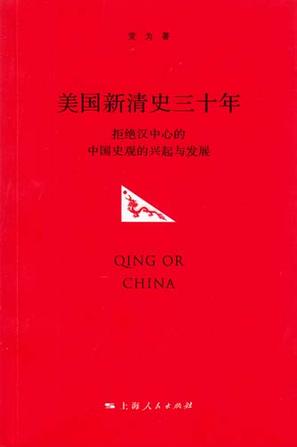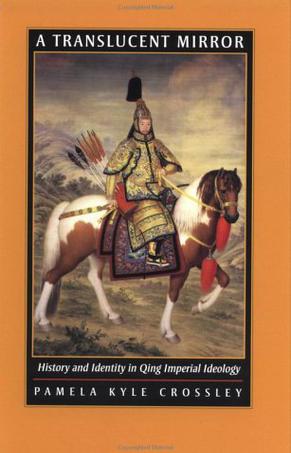欢迎来到相识电子书!
标签:新清史
-
僧侣·士人·土官
本书运用官书、方志、家谱等材料,结合当代民族志、人类学的研究方法,讨论明代云南大理人群的身份认同问题,希望提供一个明朝“统治”该地模式的解释框架。由此,严格来说本书应算是一部社会学著作。全书除绪论和结论外,分为四部分,第一部分描述明初(主要是洪武年间)明军进入大理后,明朝在大理周边设置府州县和土司,以管理当地百姓的大致过程。接着分三类人群(后三部分)来描写明朝大理的山乡社会。一是僧侣,明朝通过在大理地区册封僧侣,招僧侣入京赐给头衔,兴建寺院庄园,扶植宗教活动,建立一套符合官方意识形态的仪式宗教秩序,笼络当地信教之人。二是乡士大夫,明朝通过吸收当地读书人入京读书,参加国子监和乡试,来笼络他们。这些人在回到大理山乡后,被任命为当地的学官,负责宣传儒学,并编写符合明朝正统的家谱、族谱,同时将佛寺改造为祠堂、乡贤名宦祠。通过这一套程序,儒学正统观念、正统祀典文化在大理社会得到传播。三是土官。明朝在大理地区册封大量土司,土司之间、土官和州县之间形成政治平衡。土官在本地打击盗匪、维护地方治安和社会秩序,服从明朝的统治,同时本地经济的货币化促进了山乡流动、经济发展、身份分流和阶层整合。按照作者的建构,西南大理人群各有不同的族群、宗教、阶级类属,“国家”和“地方”各司其职并因应互动,“王朝秩序”由此得以在该地确立并维持。
-
China Marches West
From about 1600 to 1800, the Qing empire of China expanded to unprecedented size. Through astute diplomacy, economic investment, and a series of ambitious military campaigns into the heart of Central Eurasia, the Manchu rulers defeated the Zunghar Mongols, and brought all of modern Xinjiang and Mongolia under their control, while gaining dominant influence in Tibet. The China we know is a product of these vast conquests. Peter C. Perdue chronicles this little-known story of China’s expansion into the northwestern frontier. Unlike previous Chinese dynasties, the Qing achieved lasting domination over the eastern half of the Eurasian continent. Rulers used forcible repression when faced with resistance, but also aimed to win over subject peoples by peaceful means. They invested heavily in the economic and administrative development of the frontier, promoted trade networks, and adapted ceremonies to the distinct regional cultures. Perdue thus illuminates how China came to rule Central Eurasia and how it justifies that control, what holds the Chinese nation together, and how its relations with the Islamic world and Mongolia developed. He offers valuable comparisons to other colonial empires and discusses the legacy left by China’s frontier expansion. The Beijing government today faces unrest on its frontiers from peoples who reject its autocratic rule. At the same time, China has launched an ambitious development program in its interior that in many ways echoes the old Qing policies. China Marches West is a tour de force that will fundamentally alter the way we understand Central Eurasia. -
皇帝亦凡人
人們若想了解今天中國的崛起以及思考中國如何重返世界強權之列, 首先應該重新審視中國上一次擁有如此世界地位的時期, 這正是乾隆時代。 世界的乾隆 英國使者馬戛爾尼是否曾向乾隆叩頭?此一引人爭議的歷史事件長久深植人心,乾隆也因此變成停滯帝國的代言人。這一認知又伴隨著十九世紀鴉片戰爭的爆發,更把清代中國型塑為一封閉保守的帝國。 真相到底為何?「新清史」學派領軍人物歐立德將以嶄新觀點,破除此刻板印象:「經過多次交涉後,馬戛爾尼最終得償所願。他不需要叩頭,還獲准可以靠近皇上,把裝有英王喬治三世書信的錦盒遞到乾隆手中。」乾隆治下的清代中國,事實上通過諸多方式,在經濟、文化、政治、學術等層面,多方參與並影響了世界史的發展。本書更把乾隆治下的清帝國與同時代的其他帝國進行比較,讓我們得以在全球背景下解讀乾隆及其朝代,並了解清代中國並無自成一獨立體系而隔離於世界之外。 滿洲的乾隆 清代中國為何能成功建立為一盛世帝國?傳統史學的解釋是「漢化」。事實上,清朝一直被武斷地納入傳統中國王朝的框架之中。而「乾隆是海寧陳家之子」一說,更是以「漢人中心觀」為基礎之偽論。多年來,我們的歷史課本一直被這樣的史觀所掌控。 但是,本書卻讓我們看到,身為滿洲皇帝的乾隆,不僅自傲其滿人血統,同時為了降低「漢化」對滿洲文化的負面影響,更以一系列「滿洲之道」——包括提倡「國語」(即滿語)的學習、突出滿人的勇武之氣、規範薩滿之儀、編纂滿洲史籍——鞏固並強化滿洲人的族群認同。對乾隆而言,如何協調「漢人傳統」與「滿洲認同」之間的衝突,是其畢生最為關注與焦慮的統治課題。 人世的乾隆 乾隆始終被供奉在「康乾盛世」的神主牌上,他的經典肖像就是身穿滿式黃袍端坐龍椅之上。在其長達六十四年的統治之下,清帝國的實力達到頂峰,奠定了近代中國的疆域基礎。可以說,在帝國盛世的宏觀思維下,乾隆的文武雙全形象已趨神化。 然而,日常生活中的乾隆,聰明、勤奮、盡責、虛榮、衝動且易怒。他忠於家庭,更深愛他的妻子富察氏。在其晚年,乾隆將他和妻子的居所保留住原貌,似乎想藉此緬懷青春歲月。歐立德運用大量滿文文獻,解讀了乾隆對祖父、父母、皇子的親情、對后妃的愛情與對文化藝術的性情,真切還原了這位古代帝王的「凡人」面貌。 《皇帝亦凡人》一書為西方「新清史」學派大眾書寫的典範之作。傳統的清史研究限於漢文文獻,都把滿清化約為一中國王朝。歐立德精通滿文,試圖跳出「漢人中心觀」,從滿洲人的角度審視這段歷史,並立體且全方位地塑造了滿洲皇帝乾隆其「天之驕子,世之凡人」的形象。 本書特色: 一、台灣第一本「新清史」學派著作! 結合世界史觀點、滿洲視角與滿文文獻等「新清史」學派特點,本書深入審視並生動再現了滿洲皇帝乾隆及其盛世帝國。 二、本書附贈乾隆畫像別冊〈朕的平衡之道:遊走於滿洲勇士、儒家文人和藏傳佛教聖主之間〉 本別冊針對滿洲勇士、儒家文人、藏傳佛教聖主等不同乾隆形象,從宮廷畫師的視角出發,精選乾隆具代表性之圖像,帶領你探索乾隆的多元面貌與其豐富多彩的人生軌跡。 各界推薦 名人推薦: 通過這部作品,歐立德完全將乾隆和他的王朝放置於世界史的範疇之中……他對這個世界史上異常重要的人物做了簡單明瞭、極為有用而又真實動人的再評價。 ——詹姆斯.比蒂,懷卡托大學(James Beattie, University of Waikato) 歐立德將散落於各種專業論文的研究成果整合到這部具有高度可讀性的著作裡,並將自身洞見和讓人信服的關聯融入其中,得到的便是這個作為軍事領袖、藝術愛好者、滿洲傳統捍衛者、冷酷統治者和充滿熱情的旅行家的畫卷般的乾隆帝形象——一個自視甚高但又企盼向子民證明自己「中國」身分的君主。 ——《亞洲華爾街日報》(Asian Wall Street Journal) -
Our Great Qing
"In a sweeping overview of four centuries of Mongolian history that draws on previously untapped sources, Johan Elverskog opens up totally new perspectives on some of the most urgent questions historians have recently raised about the role of Buddhism in the constitution of the Qing empire. Theoretically informed and strongly comparative in approach, Elverskog’s work tells a fascinating and important story that will interest all scholars working at the intersection of religion and politics." —Mark Elliott, Harvard University "Johan Elverskog has rewritten the political and intellectual history of Mongolia from the bottom up, telling a convincing story that clarifies for the first time the revolutions which Mongolian concepts of community, rule, and religion underwent from 1500 to 1900. His account of Qing rule in Mongolia doesn’t just tell us what images the Qing emperors wished to project, but also what images the Mongols accepted themselves, and how these changed over the centuries. In the scope of time it covers, the originality of the views advanced, and the accuracy of the scholarship upon which it is based, Our Great Qing seems destined to mark a watershed in Mongolian studies. It will be essential reading for specialists in Mongolian studies and will make an important contribution and riposte to the ‘new Qing history’ now changing the face of late imperial Chinese history. Specialists in Tibetan Buddhism and Buddhism’s interaction with the political realm will also find in this work challenging and thought-provoking." —ChristopherAtwood, Indiana University Although it is generally believed that the Manchus controlled the Mongols through their patronage of Tibetan Buddhism, scant attention has been paid to the Mongol view of the Qing imperial project. In contrast to other accounts of Manchu rule, Our Great Qing focuses not only on what images the metropole wished to project into Mongolia, but also on what images the Mongols acknowledged themselves. Rather than accepting the Manchu’s use of Buddhism, Johan Elverskog begins by questioning the static, unhistorical, and hegemonic view of political life implicit in the Buddhist explanation. By stressing instead the fluidity of identity and Buddhist practice as processes continually developing in relation to state formations, this work explores how Qing policies were understood by Mongols and how they came to see themselves as Qing subjects. In his investigation of Mongol society on the eve of the Manchu conquest, Elverskog reveals the distinctive political theory of decentralization that fostered the civil war among the Mongols. He explains how it was that the Manchu Great Enterprise was not to win over "Mongolia" but was instead to create a unified Mongol community of which the disparate preexisting communities would merely be component parts. A key element fostering this change was the Qing court’s promotion of Gelukpa orthodoxy, which not only transformed Mongol historical narratives and rituals but also displaced the earlier vernacular Mongolian Buddhism. Finally, Elverskog demonstrates how this eighteenth-century conception of a Mongol community, ruled by an aristocracy and nourished by a Buddhist emperor, gave way to a pan-Qing solidarity of all Buddhist peoples against Muslims and Christians and to local identities that united for the first time aristocrats with commoners in a new Mongol Buddhist identity on the eve of the twentieth century. -
The Last Emperors
The Qing Dynasty (1644-1911) was the last and arguably the greatest of the conquest dynasties to rule China. Its rulers, Manchus from the north, held power for three centuries despite major cultural and ideological differences with the Han majority. In this book, Evelyn Rawski offers a bold new interpretation of the remarkable success of this dynasty, arguing that it derived not from the assimilation of the dominant Chinese culture, as has previously been believed, but rather from an artful synthesis of Manchu leadership styles with Han Chinese policies. -
A Court on Horseback
Between 1751 and 1784, the Qianlong emperor embarked upon six southern tours, travelling from Beijing to Jiangnan and back. These tours were exercises in political theatre that took the Manchu emperor through one of the Qing empire's most prosperous regions. This study elucidates the tensions and the constant negotiations characterising the relationship between the imperial centre and Jiangnan, which straddled the two key provinces of Jiangsu and Zhejiang. Politically, economically and culturally, Jiangnan was the undisputed centre of the Han Chinese world; it also remained a bastion of Ming loyalism and anti-Manchu sentiment. How did the Qing court constitute its authority and legitimate its domination over this pivotal region? What were the precise terms and historical dynamics of Qing rule over China proper during the long 18th Century? In the course of addressing such questions, this study also explores the political culture within and through which High Qing rule was constituted and contested by a range of actors, all of whom operated within socially and historically structured contexts. The author argues that the southern tours occupied a central place in the historical formation of Qing rule during a period of momentous change affecting all strata of the 18th-Century polity. -
Eurasian Crossroads
Eurasian Crossroads is the first comprehensive history of Xinjiang, the vast central Eurasian region bordering India, Pakistan, Afghanistan, Tajikistan, Kyrgyzstan, Kazakhstan, Russia, and Mongolia. Forming one-sixth of the People's Republic of China (PRC), Xinjiang stands at the crossroads between China, India, the Mediterranean, and Russia and has, since the Bronze Age, played a pivotal role in the social, cultural, and political development of Asia and the world. Xinjiang was once the hub of the Silk Road and the conduit through which Buddhism, Christianity, and Islam entered China. It was also the point at which the Chinese, Turkic, Tibetan, and Mongolian empires communicated and struggled with one another. Xinjiang's population comprises Kazakhs, Kirghiz, and Uighurs, all Turkic Muslim peoples, as well as Han Chinese, and competing Chinese and Turkic nationalist visions continue to threaten the region's political and economic stability. Besides separatist concerns, Xinjiang's energy resources, strategic position, and rapid development have gained it international attention in recent decades. Drawing on primary sources in several Asian and European languages, James Millward presents a thorough study of Xinjiang's history and people from antiquity to the present and takes a balanced look at the position of Turkic Muslims within the PRC today. While offering fresh material and perspectives for specialists, this engaging survey of Xinjiang's rich environmental, cultural, and ethno-political heritage is also written for travelers, students, and anyone eager to learn about this vital connector between East and West. -
嘉峪關外
清帝國是中國歷史上疆域最遼闊的國家,本書聚焦於十九世紀的嘉峪關,以及嘉峪關西邊更廣袤的新征服之地─「新疆」,這塊土地佔了今日中國國土面積的六分之一。通過考察清政府在新疆實行的財政和民族政策,尤其是對穆斯林人口最多的南疆的商業活動以及不同民族出身的商人所採取的管理和控制,作者試圖回答一個更深遠的問題:清帝國如何向民族國家過渡。這是一本新清史的經典之作,開創了清帝國邊疆研究的先河。 -
New Qing Imperial History
Product Description New Qing Imperial History uses the Manchu summer capital of Chengde and associated architecture, art and ritual activity as the focus for an exploration of the importance of Inner Asia and Tibet to the Qing Empire (1636-1911). Well-known contributors argue that the Qing was not simply another Chinese dynasty, but was deeply engaged in Inner Asia not only militarily, but culturally, politically and ideologically. Emphasizing the diverse range of peoples in the Qing empire, this book analyzes the importance to Chinese history of Manchu relations with Tibetan prelates, Mongolian chieftains, and the Turkic elites of Xinjiang. In offering a new appreciation of a culturally and politically complex period, the authors discuss the nature and representation of emperorship, especially under Qianlong (r. 1736-1795), and examine the role of ritual in relations with Inner Asia, including the vaunted (but overrated) tribute system. By using a specific artifact or text as a starting point for analysis in each chapter, the contributors not only include material previously unavailable in English but allow the reader an intimate knowledge of life at Chengde and its significance to the Qing period as a whole. -
From Frontier Policy to Foreign Policy
Between the mid-eighteenth and mid-nineteenth centuries, Qing rulers, officials, and scholars fused diverse, fragmented perceptions of foreign territory into one integrated worldview. In the same period, a single "foreign" policy emerged as an alternative to the many localized "frontier" policies hitherto pursued on the coast, in Xinjiang, and in Tibet. By unraveling Chinese, Manchu, and British sources to reveal the information networks used by the Qing empire to gather intelligence about its emerging rival, British India, this book explores China's altered understanding of its place in a global context. Far from being hobbled by a Sinocentric worldview, Qing China's officials and scholars paid close attention to foreign affairs. To meet the growing British threat, they adapted institutional practices and geopolitical assumptions to coordinate a response across their maritime and inland borderlands. In time, the new and more active response to Western imperialism built on this foundation reshaped not only China's diplomacy but also the internal relationship between Beijing and its frontiers. -
Empire at the Margins
Focusing on the Ming (1368-1644) and (especially) the Qing (1364-1912) eras, this book analyzes crucial moments in the formation of cultural, regional, and religious identities. The contributors examine the role of the state in a variety of environments on China's "peripheries," paying attention to shifts in law, trade, social stratification, and cultural dialogue. They find that local communities were critical participants in the shaping of their own identities and consciousness as well as the character and behavior of the state. At certain times the state was institutionally definitive, but it could also be symbolic and contingent. They demonstrate how the imperial discourse is many-faceted, rather than a monolithic agent of cultural assimilation. -
Emperor Qianlong
This new entry in the Longman Library of World Biography series offers an intimate and provocative account of the Manchu emperor Qianlong (1711-1799), one of the world,s great empire-builders, who helped build the foundation of the modern Chinese nation. During the 64 years of Qianlong,s rule, China,s population more than doubled, its territory increased by one-third, its cities flourished, and its manufactures - tea, silk, porcelain - were principal items of international commerce. Based on original Chinese and Manchu-language sources, and drawing on the latest scholarship, this is the biography of the man who, in presiding over imperial China,s last golden epoch, created the geographic and demographic framework of modern China. This accessible account describes the personal struggles and public drama surrounding one of the major political figures of the early modern age, with special consideration given to the emperor,s efforts to rise above ethnic divisions and to encompass the political and religious traditions of Han Chinese, Mongols, Tibetans, Turks, and other peoples of his realm. In addition to becoming familiar with one of the most remarkable figures in world history, readers will find that learning about Emperor Qianlong will add greatly to their appreciation of China,s place in the world of the eighteenth century and will deepen their understanding of China,s place in the world today. -
清代政治与国家认同
《清代政治与国家认同(套装共2册)》主要内容简介:2010年8月9日至11日,中国人民大学清史研究所主办了“清代政治与国家认同”国际学术研讨会。来自美国、日本、德国及中国两岸三地的近60名专家学者,就如何超越传统的政治史研究、重构清代政治史的认识体系进行了探讨,并从满人主体性与对满汉文化交融状态的考察出发,理陸回应了“清代的国家与民族认同”等“新清史”的重要话题。《清代政治与国家认同(套装共2册)》即是此次会议的论文辑集,分为7个部分,一共44篇文章,不仅打开一个全新的政治史研究的视野,激发了学界对“回归政治史”的强烈企盼;而且对问题意识的构建、对学术思维的磨砺,以及在学术理念与方法的突破上,都提供了很有价值的参考。 -
中國最後的帝國
清朝,是中國最後一個帝國,也是傳統中國轉向現代中國的轉捩點, 更是現代中國形成的關鍵時期。 大清帝國如何崛起,開創康雍乾盛世? 又如何經歷西方強權叩關,走向衰亡? 這段波瀾壯闊、風雲變色的歷史,在本書有最精采的描繪與解析。 本書作者羅威廉是《劍橋大學中國史》(The Cambridge History of China)系列作者群之一,是當今西方研究清史的權威學者。《中國最後的帝國:大清王朝》是繼魏斐德《大清帝國的衰亡》、史景遷《追尋現代中國:最後的王朝》之後,西方史學界極具代表性的清史研究專書,更為近半世紀西方清史研究的集大成之作。 本書是美國哈佛大學出版社《帝制中國史》(History of Imperial China)系列中的最後一冊,全書綜合近數十年來美國清史學界的新研究成果,呈現包括社會史研究、內亞轉向和歐亞轉向等三個重要的新取向。作者羅威廉教授從這些觀點出發,把大清帝國的歷史放入前後更長時段的中國史脈絡,以及更廣闊空間的全球性觀點中。書中以主題為主、時序為輔的方式安排章節,深入淺出地探討清代各時期的政治、社會、經濟、文化等各重要主題,分析與敘述兼長且極具可讀性。雖然本書原為針對美國讀者撰寫,然而對於想一窺歐美清史學界近數十年發展概要的臺灣讀者而言,仍是極佳的入門之作。 羅威廉在本書中運用西方的「帝國」概念恰如其分地詮釋清朝的歷史位置:清朝將蒙古、女真、西藏及其他非漢民族,成功地整合為一種新型態、超越性的政治體,類似近代早期歐亞大陸型態之多民族普世帝國,是民族主義浮現檯面前的政治形式。 名家推薦 羅威廉教授是馳名國際的清史專家,他這本《中國最後的帝國:大清王朝》,成功地綜合了國際及中國清史學界過去數十年的成果,具有典範性的價值。此書拋棄了清朝無能保守及中國近代史起於西力入侵的傳統觀點,將清朝視為一個克服種種挑戰、成就斐然而必須完整視之的重要斷代,以深入展現中國近代歷史自身演變的特質。作者同時融合了新清史、社會史、內亞史、東亞史以及比較世界歷史的眼光,對於清代歷史各重要階段的起源、發展及特性,做出了完整而深刻的詮釋。是以本書堪稱這數十年來海外清史研究最重要的通論性作品,為研究清史及中國近現史者所必讀。 --吳展良,國立臺灣大學歷史學系教授 作者羅威廉在本書〈導言〉中說:歷史學家們現在對大清帝國的理解,與四、五十年前我們所曾經理解的大不一樣了。感謝作者羅威廉,本書夾敘夾議式的宏大敘事,不僅讓我們看到了半個世紀以來西方最富有活力的清史領域產出的豐碩成果,並且通過此一對比,領會五十年來人們對大清帝國的理解確實已經「大不一樣」。這一點也提醒華語史學界應更加重視西方同行研究清史過程中基本概念的重構(basic reconceptualization)和相關理論支架的可驗證性(testability of the related theoretical underpinnings)。 --張廣達,中央研究院院士、國立政治大學歷史學系講座教授 羅威廉在這本精湛傑出的研究著作中,將最新的清史研究推介給一般讀者。《中國最後的帝國》為作者畢生研讀清史此領域之最新力作,對於我們瞭解中國史,這是一本治學嚴謹、值得信賴的重要之作。 --蓋博堅(R. Kent Guy),華盛頓大學歷史學系教授 這是一本來自美國史學界的中國史嶄新論述。自1644年由非漢族的滿洲人征服明朝那一刻開始,傳統中國逐漸變得不太一樣。這意謂著過去以費正清為首的哈佛學派,其強調中國朝代更迭、道統延續的概念必須被摒棄……簡而言之,一如作者羅威廉教授在此書中所陳述,「內向封閉的天朝帝國」雖然業已消失,更有趣的卻在我們面前上演著。 --Jonathan Mirsky ,《泰晤士報文學評論》(Times Literary Supplement)書評 一本針對中國史這段重要時代的最佳研究。 --K. E. Stapleton,《Choice》書評 -
China's Last Empire
In a brisk revisionist history, William Rowe challenges the standard narrative of Qing China as a decadent, inward-looking state that failed to keep pace with the modern West. The Great Qing was the second major Chinese empire ruled by foreigners. Three strong Manchu emperors worked diligently to secure an alliance with the conquered Ming gentry, though many of their social edicts—especially the requirement that ethnic Han men wear queues—were fiercely resisted. As advocates of a “universal” empire, Qing rulers also achieved an enormous expansion of the Chinese realm over the course of three centuries, including the conquest and incorporation of Turkic and Tibetan peoples in the west, vast migration into the southwest, and the colonization of Taiwan. Despite this geographic range and the accompanying social and economic complexity, the Qing ideal of “small government” worked well when outside threats were minimal. But the nineteenth-century Opium Wars forced China to become a player in a predatory international contest involving Western powers, while the devastating uprisings of the Taiping and Boxer rebellions signaled an urgent need for internal reform. Comprehensive state-mandated changes during the early twentieth century were not enough to hold back the nationalist tide of 1911, but they provided a new foundation for the Republican and Communist states that would follow. This original, thought-provoking history of China’s last empire is a must-read for understanding the challenges facing China today. -
清帝國性質的再商榷
近年美國學界流行「新清史」之說,認為清朝是中亞帝國而非中華帝國,且以譴責所謂大中國沙文主義為藉口來否定漢化,以混淆族群認同與國家認同來論證清朝並不認同中國,其言外之意質疑中國領土主張的歷史正當性,呼之欲出。顯而易見,所謂「新清史學派」無疑在大做翻案文章,以「新見」引世人注目,但無論在理據上與事據上都難以自圓其說。本書由海峽兩岸八位歷史學者分別提出論文,在學術會議上共同商榷後,整編而成。八篇論文聚焦於同一主題,從不同角度,諸如文化、學理、族群、漢化、認同、教育、制度,以及中國觀多方面,回應了「新清史」的論述,肯定了清朝是中華帝國的延伸,中國從秦至清原是多民族帝國,不僅漢化,也有胡化,清朝並不是中國歷史上唯一非漢族建立的朝代,豈能獨外於中國?本書內容豐富,文筆犀利,不僅有高度的學術價值,而且頗具可讀性,值得推薦給廣大的讀者。 -
美国新清史三十年
本书以不同领域内的开创性著作或代表性著作的出版时间为序,分八个专题进行论述,即强调中国内部因素的民众史、全球背景下的经济史、以原始档案为主要材料的新官方史和精英史、注重社会史内容的新法律史、新视角下的清代城市史、满洲及清代族群研究、国际帝国竞争中的清代外交与边疆史、妇女史研究。作者认为新清史在推进中国重估清代对中国历史和现实的重要意义方面将发挥积极作用的同时,可能对中国的历史和现实产生致命伤害。 -
A Translucent Mirror
In this landmark exploration of the origins of nationalism and cultural identity in China, Pamela Kyle Crossley traces the ways in which a large, early modern empire of Eurasia, the Qing (1636-1912), incorporated neighboring, but disparate, political traditions into a new style of emperorship. Drawing on a wide variety of primary sources, including Manchu, Korean, and Chinese archival materials, Crossley argues that distortions introduced in seventeenth- and eighteenth-century historical records have blinded scholars to the actual course of events in the early years of the dynasty. This groundbreaking study examines the relationship between the increasingly abstract ideology of the centralizing emperorship of the Qing and the establishment of concepts of identity in the seventeenth and eighteenth centuries, before the advent of nationalism in China. Concluding with a broad-ranging postscript on the implications of her research for studies of nationalism and nation-building throughout modern Chinese history, A Translucent Mirror combines a readable narrative with a sophisticated, revisionary look at China's history. Crossley's book will alter current understandings of the Qing emperorship, the evolution of concepts of ethnicity, and the legacy of Qing rule for modern Chinese nationalism.
热门标签
下载排行榜
- 1 梦的解析:最佳译本
- 2 李鸿章全传
- 3 淡定的智慧
- 4 心理操控术
- 5 哈佛口才课
- 6 俗世奇人
- 7 日瓦戈医生
- 8 笑死你的逻辑学
- 9 历史老师没教过的历史
- 10 1分钟和陌生人成为朋友

